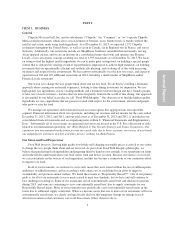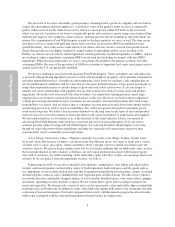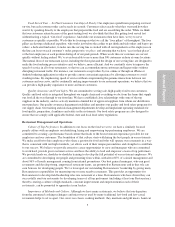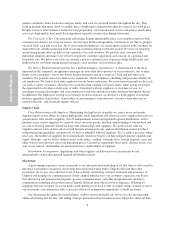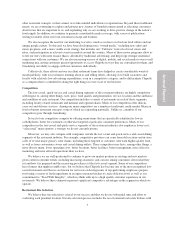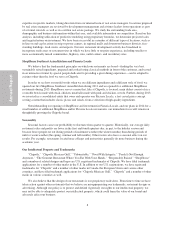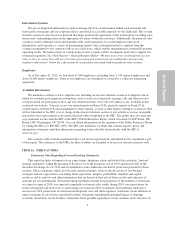Chipotle 2013 Annual Report Download - page 15
Download and view the complete annual report
Please find page 15 of the 2013 Chipotle annual report below. You can navigate through the pages in the report by either clicking on the pages listed below, or by using the keyword search tool below to find specific information within the annual report.
We may also find it more difficult in international markets to hire, motivate and keep qualified employees
who can project our vision, passion and culture. In addition, restaurants outside the U.S. have had higher
construction, occupancy and operating costs than restaurants in existing markets, and we may have difficulty
finding reliable suppliers or distributors or ones that can provide us, either initially or over time, with adequate
supplies of ingredients meeting our quality standards. Markets outside the U.S. may also have regulatory
differences with the U.S. with which we are not familiar, or that subject us to significant additional expense or to
which we are not able to successfully adapt, which may have a particularly adverse impact on our sales or
profitability in those markets and could adversely impact our overall results. Our overall results may also be
affected by currency risk on the transactions in other currencies and translation adjustments resulting from the
conversion of our international financial results into the U.S. dollar.
ShopHouse Southeast Asian Kitchen and Pizzeria Locale may not contribute to our growth.
We believe that the fundamental principles on which Chipotle restaurants are based—finding the very best
sustainably raised ingredients, prepared and cooked using classical methods in front of the customer, and served in
an interactive format by special people dedicated to providing a great dining experience—can be adapted to cuisines
other than the food we serve at Chipotle. In order to see how our model works when we use different ingredients
and a different style of food, we opened ShopHouse Southeast Asian Kitchen during 2011 and now have a total of
six ShopHouse restaurants, in Washington D.C. and the Los Angeles area. We also announced in late 2013 that we
have invested in a company operating a new fast casual Pizzeria Locale restaurant in Denver, Colorado, and that we
plan to invest in and assist with the expansion of Pizzeria Locale in the future. ShopHouse and Pizzeria Locale are
new brands and they have lower brand awareness, lower sales and less operating experience than most Chipotle
restaurants, and may not achieve the same restaurant economics as Chipotle restaurants. Notwithstanding our
opening of ShopHouse and investment in Pizzeria Locale, our immediate focus will remain on thoughtfully growing
the Chipotle brand. As a result, we do not expect ShopHouse or Pizzeria Locale to contribute to our growth in a
meaningful way for at least the next several years, and we may determine not to move forward with any further
expansion of ShopHouse or Pizzeria Locale. This would limit our overall growth over the long term.
Our failure to manage our growth effectively could harm our business and operating results.
As described elsewhere in this report, our plans call for a significant number of new restaurants. Our
existing restaurant management systems, financial and management controls, information systems and personnel
may be inadequate to support our expansion. Managing our growth effectively will require us to continue to
enhance these systems, procedures and controls and to hire, train and retain general managers, crew and
corporate staff. We also are continuing to attempt to improve our field management in an effort to develop
additional top-performing general managers more quickly. We may not respond quickly enough to the changing
demands that our expansion will impose on management, crew and existing infrastructure, and changes to our
operating structure may result in increased costs or inefficiencies that we cannot currently anticipate. Changes as
we grow may have a negative impact on the operation of our restaurants, and cost increases resulting from our
inability to effectively manage our growth could adversely impact our profitability. We also place a lot of
importance on our culture, which we believe has been an important contributor to our success. As we grow, we
may have difficulty maintaining our culture or adapting it sufficiently to meet the needs of our operations. Our
failure to foster and maintain our corporate culture could also harm our business and operating results.
Risks Related to Operating in the Restaurant Industry
Changes in food and supply costs could adversely affect our results of operations.
Our profitability depends in part on our ability to anticipate and react to changes in food and supply costs.
Like all restaurant companies, we are susceptible to increases in food costs as a result of factors beyond our
control, such as general economic conditions, seasonal fluctuations, weather conditions, global demand, food
safety concerns, generalized infectious diseases, fluctuations of the U.S. dollar, product recalls and government
regulations. The cost of many basic foods for humans and animals, including corn, wheat, rice and cooking oils,
has increased markedly in some years, resulting in upward pricing pressures on almost all of our raw ingredients
including chicken, beef, tortillas and rice, increasing our food costs. Food prices for a number of our key
13
Annual Report


